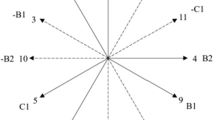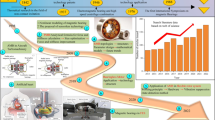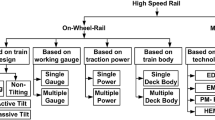Abstract
This paper investigates the structural-electromagnetic coupled problem of a permanent magnet assisted-synchronous reluctance motor (PMa-SynRM) for railway vehicles considering the barrier filling. The PMa-SynRM is suitable as a traction motor for railway vehicles but is vulnerable to the structural stability of the rotor under centrifugal force. Therefore, the structural characteristics of the PMa-SynRM should be considered, and the structural influences on the electromagnetic performance are also important based on the stress-dependent properties of the electrical steel core. To improve the structural stability, the concept of barrier filling is proposed, which involves inserting a substance into the magnetic flux barrier region of the PMa-SynRM and balancing the loads in the rotor core. The structural analysis results with the barrier fillings are compared for a wide range of their physical properties. We input stress and strain data by element into the rotor electrical steel core of the electromagnetic model, which consists of the identical mesh as the rotor structural analysis results and set conditions to reflect the stress-dependent B-H and iron loss data to analyze the electromagnetic performance including coupled effects. Finally, the best filling substance is derived and applied based on the previous structural analysis results, clarifying the improvement in the structural and electromagnetic characteristics.




















Similar content being viewed by others
References
Nategh S, Boglietti A, Liu Y, Barber D, Brammer R, Lindberg D, Aglen O (2020) A review on different aspects of traction motor design for railway applications. IEEE Trans Ind Appl 56(3):2148–2157
Han P-W, Seo U-J, Paul S, Chang J (2022) Computationally efficient stator ac winding loss analysis model for traction motors used in high-speed railway electric multiple unit. IEEE Access 10:28725–28738
Ronanki D, Singh SA, Williamson SS (2017) Comprehensive topological overview of rolling stock architectures and recent trends in electric railway traction systems. IEEE Trans Transport Electrific 3(3):724–738
Paul S, Han P-W, Chang J, Chun Y-D, Lee J-G (2022) State-of-the-art review of railway traction motors for distributed traction considering South Korean high-speed railway. Energy Rep 8:14623–14642
Lee H-W, Park C-B, Lee B-S (2012) Performance comparison of the railway traction IPM motors between concentrated winding and distributed winding. In: Proc IEEE Transp Electrific Conf Expo (ITEC), pp 1–4
Pan Z, Chen M, Lu S, Tian Z, Liu Y (2020) Integrated timetable optimization for minimum total energy consumption of an AC railway system. IEEE Trans Veh Technol 69(4):3641–3653
Jahns T, Caliskan V (1999) Uncontrolled generator operation of interior pm synchronous machines following high-speed inverter shutdown. IEEE Trans Ind Appl 35(6):1347–1357
Niazi P, Toliyat HA, Goodarzi A (2007) Robust maximum torque per ampere (MTPA) control of pm-assisted synrm for traction applications. IEEE Trans Veh Technol 56(4):1538–1545
Pellegrino G, Vagati A, Guglielmi P (2011) Design tradeoffs between constant power speed range, uncontrolled generator operation, and rated current of ipm motor drives. IEEE Trans Ind Appl 47(5):1995–2003
Kim W-H, Kim K-S, Kim S-J, Kang D-W, Go S-C, Chun Y-D, Lee J (2009) Optimal PM design of pma-synrm for wide constant-power operation and torque ripple reduction. IEEE Trans Magn 45(10):4660–4663
Park G-J, Kim J-S, Son B, Jung S-Y (2018) Optimal design of PMa-SynRM for an electric propulsion system considering wide operation range and demagnetization. IEEE Trans Appl Supercond 28(3):1–4
López-Torres C, Garcia A, Riba J-R, Lux G, Romeral L (2018) Computationally efficient design and optimization approach of pma-synrm in frequent operating torque–speed range. IEEE Trans Energy Convers 33(4):1776–1786
Taghavi SM, Pillay P (2015) A mechanically robust rotor with transverse laminations for a wide-speed-range synchronous reluctance traction motor. IEEE Trans Ind Appl 51(6):4404–4414
Bao Y, Degano M, Wang S, Chuan L, Zhang H, Xu Z, Gerada C (2020) A novel concept of ribless synchronous reluctance motor for enhanced torque capability. IEEE Trans Ind Electron 67(4):2553–2563
Bonthu SSR, Choi S, Baek J (2018) Design optimization with multi-physics analysis on external rotor permanent magnet-assisted synchronous reluctance motors. IEEE Trans Energy Convers 33(1):290–298
Zhao W, Shen H, Lipo TA, Wang X (2018) A new hybrid permanent magnet synchronous reluctance machine with axially sandwiched magnets for performance improvement. IEEE Trans Energy Convers 33(4):2018–2029
Ngo D-K, Hsieh M-F, Huynh TA (2019) Torque enhancement for a novel flux intensifying pma-synrm using surface-inset permanent magnet. IEEE Trans Magn 55(7):1–8
Mohammadi A, Mirimani SM (2022) Design of a novel pm-assisted synchronous reluctance motor topology using v-shape permanent magnets for improvement of torque characteristic. IEEE Trans Energy Convers 37(1):424–432
**ng Z, Wang X, Zhao W (2022) Rotor stress analysis of high-speed surface-mounted permanent magnet motors with segmented poles considering fillings. J Electr Eng Technol. https://doi.org/10.1007/s42835-022-01307-9
Zhang H, Zeng L, An D, Pei R (2022) Magnetic performance improvement caused by tensile stress in equivalent iron core fabricated by high-strength non-oriented electrical steel. IEEE Trans Magn 58(2):1–5
Unniachanparambil GM, Rane R, Kulkarni SV (2024) Influence of compressive stress on the magnetic characteristics of grain-oriented material under non-sinusoidal excitation. J Magn Magn Mater 590:171148
Bianchi N, Fornasiero E, Soong W (2015) Selection of pm flux linkage for maximum low-speed torque rating in a pm-assisted synchronous reluctance machine. IEEE Trans Ind Appl 51(5):3600–3608
Huynh TA, Hsieh M-F, Shih K-J, Kuo H-F (2018) An investigation into the effect of pm arrangements on pma-synrm performance. IEEE Trans Ind Appl 54(6):5856–5868
Huynh TA, Hsieh M-F (2019) Irreversible demagnetization analysis for multilayer magnets of permanent magnet-assisted synchronous reluctance machines considering current phase angle. IEEE Trans Magn 55(7):1–9
Maroufian SS, Pillay P (2019) Design and analysis of a novel pm-assisted synchronous reluctance machine topology with alnico magnets. IEEE Trans Ind Appl 55(5):4733–4742
Bianchi N, Bolognani S, Bon D, Dai Pre M (2009) Rotor flux-barrier design for torque ripple reduction in synchronous reluctance and pm-assisted synchronous reluctance motors. IEEE Trans Ind Appl 45(3):921–928
Ko H-S, Kim K-J (2004) Characterization of noise and vibration sources in interior permanent-magnet brushless dc motors. IEEE Trans Magn 40(6):3482–3489
Yan D, Chen Z, Wang Z, Wang H, Shi T, **a C (2022) The torque ripple reduction in pmarel machine using time-space harmonics analysis of air-gap flux density. IEEE Trans Ind Electron 69(3):2390–2401
Kong Y, Lin M, Yin M, Hao L (2018) Rotor structure on reducing demagnetization of magnet and torque ripple in a PMma-SynRM with ferrite permanent magnet. IEEE Trans Magn 54(11):1–5
Li X, Sun Z, Sun W, Guo L, Wang H (2023) Design of permanent magnet-assisted synchronous reluctance motor with low torque ripple. World Electr Veh J 14(4):82
Lu Y, Li J, Qu R, Ye D, Lu H, Sun J, Ge M, Xu H (2018) Electromagnetic force and vibration analysis of permanent-magnet-assisted synchronous reluctance machines. IEEE Trans Ind Appl 54(5):4246–4256
Lu Y, Li J, Xu H, Yang K, **ong F, Qu R, Sun J (2021) Comparative study on vibration behaviors of permanent magnet assisted synchronous reluctance machines with different rotor topologies. IEEE Trans Ind Appl 57(2):1420–1428
Yamazaki K, Takeuchi H (2017) Impact of mechanical stress on characteristics of interior permanent magnet synchronous motors. IEEE Trans Ind Appl 53(2):963–970
Acknowledgements
This work is supported by Korea Institute of Energy Technology Evaluation and Planning (KETEP) grant funded by the Korea government (MOTIE) (20224000000440, Sector coupling energy industry advancement manpower training program)
Author information
Authors and Affiliations
Corresponding author
Additional information
Publisher's Note
Springer Nature remains neutral with regard to jurisdictional claims in published maps and institutional affiliations.
Appendices
Appendix A
This Appendix discusses the general limitation of the material properties of the electrical steel core. The limitation is introduced in Sect. 3 and is similar to those reported in previous studies regarding stress-dependent electrical steels [20, 21]. Therefore, the impact of this limitation on the coupled analysis should be discussed. The detailed contour image plots at a high-speed operating point of 366.66 Nm and 6,000 rpm are presented in Fig.
21. The mechanical stresses, including the major- and minor-PS, were concentrated in the bridge ribs, as shown in Fig. 21a, b. The other regions were under a relatively low stress and the limitation was insignificant. Figure 21c shows that the iron loss density is not high in the bridge ribs because variations in the magnetic flux are important for iron loss. The regions of PS and iron loss did not directly match, and a PS value of greater than 100 MPa affected the low-loss region. Therefore, the limitations of the stress-dependent property data were not significant. However, if further research is conducted in the future and stress-dependent data are studied over a larger area, these limitations may not need to be considered.
Appendix B
The structural characteristics were analyzed for a wide range of physical properties in Sect. 5.2, and a bamboo was proposed as the best substance in Sect. 7.1. Other candidate substances are introduced, and their physical properties and analysis results are derived in Table
7. While there are many candidate substances provided by GRANTA, some substances that were considered suitable, were selected, and analyzed. Suitability is determined by the values of MD, PR, and YM being in the general range of non-negative values, excluding materials that are not at the level to be used in electric motor development, such as diamond.
The results were varied, and some substances have trade-off characteristics and have the potential to be optimal. Pine wood reduces VMS slightly less, but it has the lowest MD of the candidates, which is more favorable in terms of weight reduction and improving the power density of the motor. Concrete lags behind in the aforementioned characteristics but has advantages when considering the manufacturability of the practical motor, making it a prime candidate in some cases.
Previous reference studies [13, 14, 16] suggested the effect of epoxy adhesive bonding, it was also included in the substance candidates, which improved the FOS 1.92 times better than air filling. Therefore, the effectiveness of the epoxy resin filling considered in the previous studies was verified, and the improvement results in this paper can also be confirmed.
Rights and permissions
Springer Nature or its licensor (e.g. a society or other partner) holds exclusive rights to this article under a publishing agreement with the author(s) or other rightsholder(s); author self-archiving of the accepted manuscript version of this article is solely governed by the terms of such publishing agreement and applicable law.
About this article
Cite this article
Kang, SG., Kang, D.H., Kim, HW. et al. Coupled Problem Study with Structural Analysis Considering Barrier Filling of PMa-SynRM for Railway Vehicle. J. Electr. Eng. Technol. (2024). https://doi.org/10.1007/s42835-024-01924-6
Received:
Revised:
Accepted:
Published:
DOI: https://doi.org/10.1007/s42835-024-01924-6





